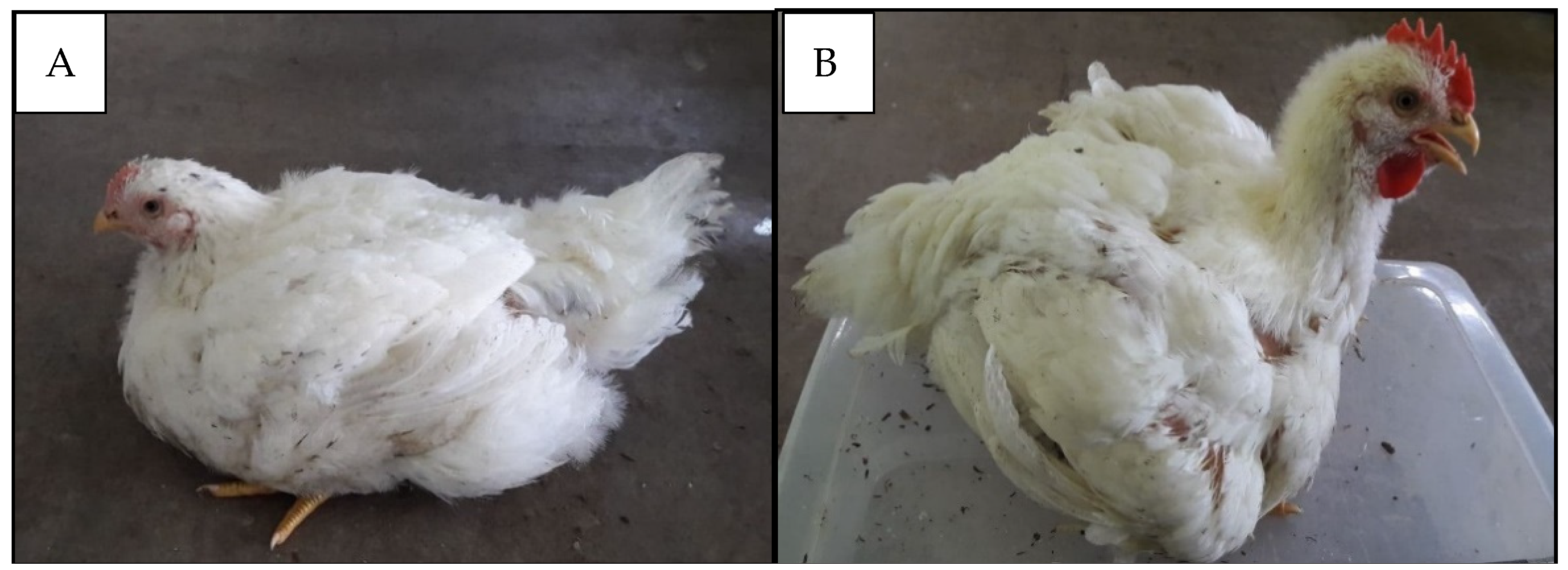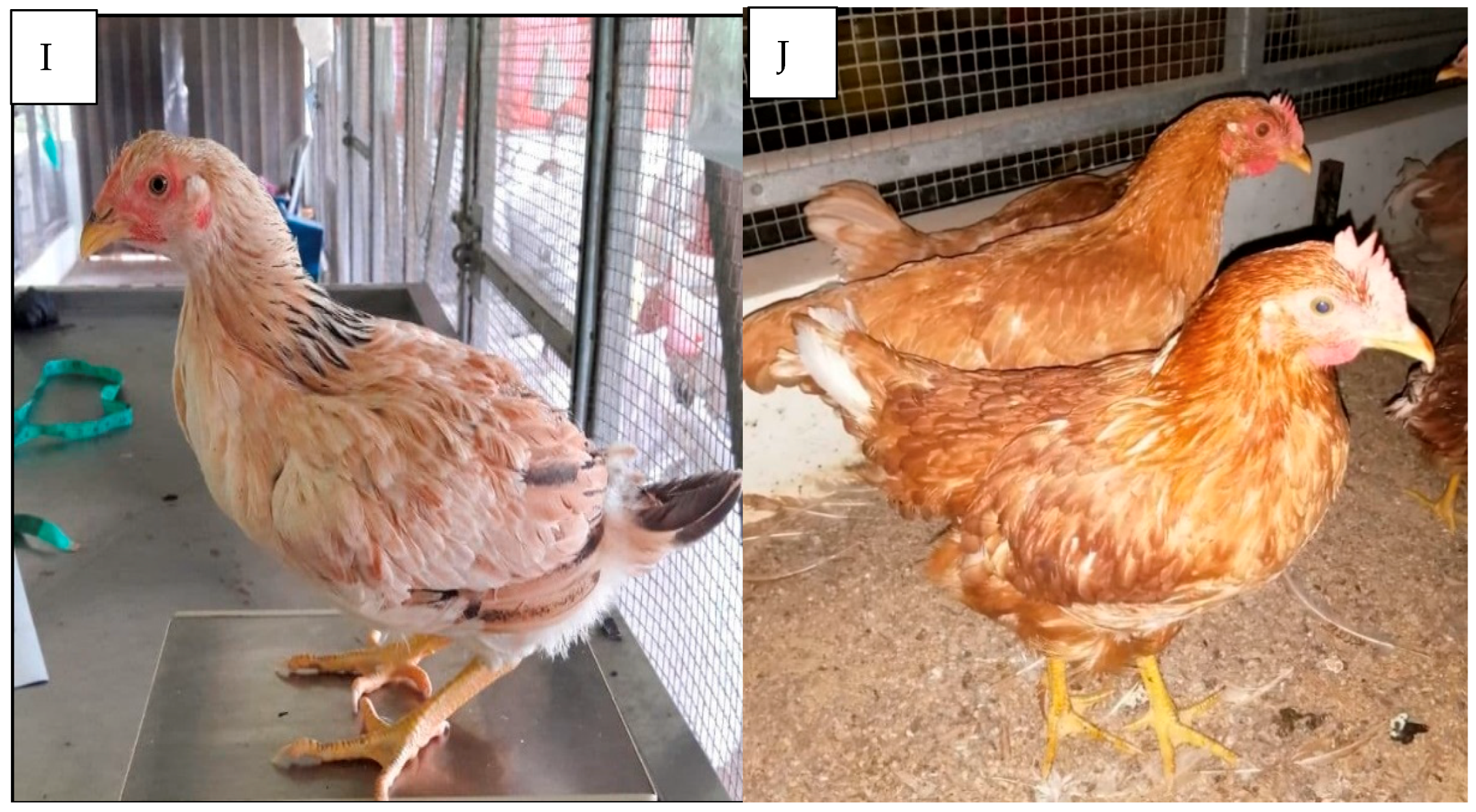It is well-documented that the genetic background of various animal breeds is one of the influential factors, which has a dominant effect on livestock phenotypic characteristics [
30,
31]. Since even close species/breeds may not share quantitative trait loci because of recombination [
32], it can be concluded that each breed has its own genetic makeup, which leads to specific phenotypes. Likewise, the study by Mohsin et al. underlined the importance of goat breed on the chemical composition of milk, in which chemical composition of milk can be used as the potential criteria for the classification of goat breeds [
33]. Host genomic variants analysis in pigs demonstrated that the host genome can impact the phenotypic traits by instigating a change in the gut microbiome composition that changes the phenotype (fat deposition) [
31]. In chicken, genetic selection, which has been made to improve production traits in broiler chickens and reproductive traits in laying hens, caused remarkable differences in the growth rate and development traits among chicken breeds. These differences can be seen in traits such as growth rate, muscle fat content, feed consumption, and muscle development, which are due to both genetic and epigenetic modifications [
34]. Likewise, the quantification of genetic variants related to economically important traits, muscle, and meat quality traits in chicken revealed that there were significant amounts of genetic variation for these traits among and within commercial broilers, layers, and traditional chickens [
35].
3.1.1. Live Body Weight and Linear Body Measurements
Results of the breed effects on body size traits (
Table 2) indicated that four breeds in this study can completely be divided into two distinct groups, including fast-growing chickens (Cobb and Hubbard) and slow-growing chickens (DeKalb and village chicken), based on the wingspan and chest circumference, of which the latter is the indicator of fleshing in chicken [
36]. However, other body size traits, including body length and shank length, were not a significant discriminator of chicken breeds. For instance, Cobb and village chicken as well as Cobb and DeKalb had the same value for the body length and shank length, respectively. While Hubbard had a significantly higher mean value for both traits (
Table 2).
Wingspan and chest circumference values in Hubbard and Cobb, as fast-growing chicken breeds, were significantly (
p < 0.05) higher than slow-growing chicken breeds, including DeKalb and village chicken. Likewise, the higher mean value for both traits belonged to Hubbard, followed by Cobb. In fact, Hubbard and Cobb had a significantly (
p < 0.05) higher value for most of the phenotypic variables, including wingspan, chest circumference, live weight, carcass weight, and breast muscle weight, compared to village chicken and DeKalb (
Table 2).
Moreover, chest circumference in the broiler (Cobb) had a dominant higher value compared to Malaysian village chicken, which is approved by the study of Lokman et al. [
6] who revealed that broiler (Ross) had significantly higher chest circumference compared to Malaysian village chicken.
Overall, Hubbard had a higher mean value for body weight and linear body measurements compared to other breeds. Accordingly, Hubbard was heavier and longer/taller than other breeds in this study at their market age (
Table 2).
3.1.2. Carcass Characteristics
Carcass traits were strongly influenced by chicken types, and the most significant differences were observed in value for breast muscle weight. Breast muscle weight was the heaviest (
p < 0.05) in the Cobb population, followed by Hubbard, DeKalb, and village chicken. In other words, breast muscle weight in Cobb had a significantly (
p < 0.05) higher mean value (489.706 g) compared to other breeds (
Table 2), which confirmed the main goal of commercial broiler chicken production for achieving high-yield breast muscles as the most valuable piece of chicken carcass [
6]. In contrast, village chicken had the lowest mean value (
p < 0.05) for breast weight (
Table 2), which had conformity with its low-growth rate. The second heaviest breast muscle value belonged to Hubbard (359.974 g), followed by DeKalb. DeKalb is a slow-growing chicken, which had a higher proportion of breast weight (248.824 g) compared to the village chicken at their market age, while the breast muscle in DeKalb was lighter and flatter compared to commercial broiler examined in this study (
Table 2). This result is in agreement with the study of Mueller et al., who indicated that the breast weight (g) of commercial fast-growing broiler (Ross PM3) (521 g) was significantly higher than the colored broiler (Sasso 51) (335 g), layer (Lohmann Brown plus) (130 g), and two traditional chicken lines. In which, the breast weight in the layer line and two traditional chicken lines was significantly lower than the commercial broiler and colored broiler lines [
27].
Regarding body weight, since four chicken breeds under study had different market ages, it is not surprising that there were significant differences in live and carcass weight among the breeds. However, Cobb and Hubbard significantly grouped together and differentiated from slow-growing chicken breeds (village chicken and DeKalb) based on the live and carcass weight (
Table 2). These results are in agreement with the study of Lokman et al. [
6] that indicated that the mean whole carcass weight in the high-performance breed (broiler-Ross) was higher compared with a lower-performance breed (Malaysian village chicken).
Dressing percentage (DP) is an important criterion for the evaluation of the slaughter value of broiler carcass. Broiler chickens normally possess a high DP, accounting for 74.81% compared to other breeds [
37]. In this study, Cobb had a significantly (
p < 0.05) higher DP (71.81%) compared to other breeds. The high DP is an indicator of the highest carcass yield in the Cobb as a genetically improved chicken breed to reach the highest weight in a short time. Furthermore, as mentioned earlier, Cobb had the heaviest breast muscle weight compared to other breeds, which can be matched with its highest DP. Subsequently, the lowest DP was observed in the DeKalb (60.76%) (
Table 2). Probably, it can be explained by the observation during slaughter, in which some of the layer chickens still had eggs inside their stomach that caused higher live weight compared to the carcass weight, and consequently, lower DP. Despite the almost same mean live weight value in broiler and colored broiler breeds, DP in Cobb was higher than Hubbard, followed by village chicken and DeKalb (
Table 2). This result was consistent with the results of Mueller et al., who showed that commercial fast-grower chickens (Ross PM3) had a significantly higher DP, followed by colored broiler (Sasso 51), traditional chicken breeds, and layer [
27].
Since excessive fat accumulation in the abdominal cavity is the main problem of the chicken production industry, specifically broiler production, abdominal fat content is the major phenotypic indices of fat trait [
38]. In this study, chicken breeds significantly (
p < 0.05) influenced abdominal fat weight (AbFW). Likewise, Hubbard had significantly higher AbFW (72.56 g) compared to other breeds, followed by DeKalb (58.51 g), Cobb (29.28 g), and then village chicken (0.34 g) (
Table 2). The most notable difference was observed in the AbFW of village chicken, being extensively lower than Hubbard and Cobb. Similarly, another study indicated that the AbFW was in the highest value in the colored broiler (Sasso 15) compared to broiler-Ross, layer, and traditional chickens. They highlighted that the housing system, where chickens move minimally, and the dense diet high in energy were the reasons for an extraordinary great proportion of abdominal fat in colored broilers [
27]. The study by Lokman et al. [
6] also revealed that broiler (Ross) had the highest mean fat weight compared to Malaysian village chicken, which is in agreement with the present study. In other investigations, the proportion of abdominal fat in commercial broilers was significantly (
p < 0.05) higher compared with layers [
27,
35] due to the genetic selection of commercial broiler to produce maximal meat, which increases the fat content [
39]. In contrast, in the present study, the layer-DeKalb had significantly higher AbFW compared to the Cobb. The reason for this variation can be explained by the differences in layer breeds, slaughter age, and the maturity level of chickens in the current study compared to other investigations. For instance, since the main concern of this research was to investigate common chicken breeds in the Malaysian market, layer chickens were inspected at their late-laying period (48 weeks), in which their laying ability is extremely reduced [
40], and can be used as meat in the market. It is worth noting that there is increased fat deposition and decreased lipid metabolism ability in late-laying hens compared to peak-laying hens, and therefore layer chickens in this study had notable fat content in the abdominal cavity [
41].
On the other hand, village chickens had the lowest abdominal fat content, which is consistent with their nature, including eating behavior and maximal activity during the rearing duration, that leads to strong and tough muscle and low AbFW [
6]. Similarly, another study in China showed that a local chicken breed named Biacheng-You chickens had much lower abdominal fat weight compared to Arbor Acres broilers as a commercial chicken breed [
39]. Comparison of fatness and meat quality traits among Kampung (Indonesia’s native chicken), Arabic (local chicken), and the laying-type chickens showed similar findings in which type of chicken had affected the levels of abdominal fat and fat level of meat. Correspondingly, it is revealed that laying-type chickens had significantly higher abdominal fat content and meat fat (g/100 g) compared to the other two breeds, indicating different metabolism rate or energy retention patterns for fat establishment and development in each chicken breed [
42]. Moreover, abdominal fat variation also happened among broiler chickens, where among three broiler breeds (Ross 308, Hubbard Flex, and Hubbard F15), Hubbard Flex had the highest abdominal fat content [
16].
Overall, it can be concluded that phenotypic characteristics of chickens can be extensively influenced by chicken breeds. Therefore, phenotypic traits including body size and carcass traits can be a significant indicator for grouping and differentiation of different chicken breeds before and after slaughter at their market age. In this study, the most remarkable differentiating factors can be breast muscle weight, chest circumference, body size, carcass weight, and abdominal fat weight. Furthermore, among all studied breeds, Hubbard had a higher value for all traits except for carcass weight, dressing percentage, and breast weight, whereas Cobb had higher values for these phenotypes. In contrast, village chicken had the lowest value for live and carcass weight, breast weight, and abdominal fat weight. Based on the results, it can be observed that DeKalb held the significant middle stage for most variables. However, the highest and lowest abdominal fat weight and dressing percentage respectively, belonged to the DeKalb.















